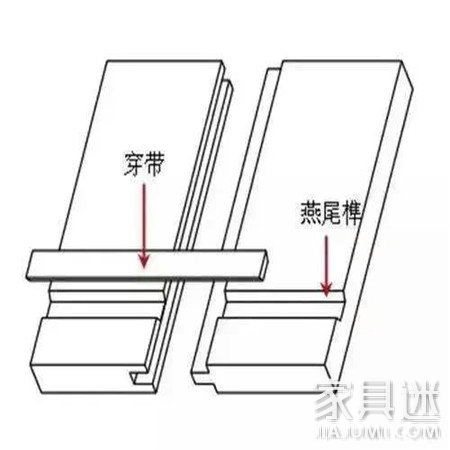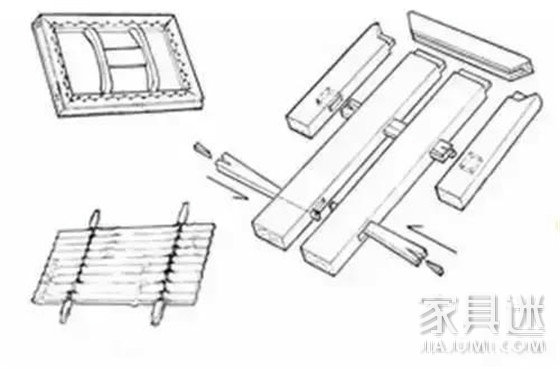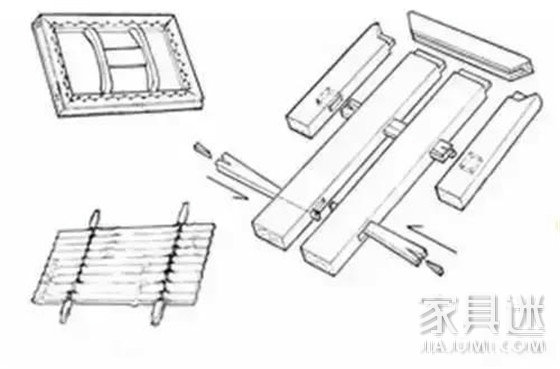In fact, no matter what kind of furniture, there are their own professional terms. And ancient Chinese furniture has its own unique furniture terminology - wearing a belt. When you hear the word "wearing", is there a lot of questions about wearing the belt in your mind? Today, Xiaobian will take you into the world of "band"!
Ancient furniture terminology: belt
The word "belt" in Chinese mainly refers to a relatively flat strip that can tighten an object. In the ancient woodworking terminology, it refers to a type of crossbar that runs through the inside of the plane part of the wood and acts as a tube bundle for its deformation. Because it is mostly placed in the middle of the board, it is very similar to the belt of a person, so it is commonly called "belt". The biggest difference between it and the "waist" is that the belt can control the board to prevent its deformation, but it does not cut off its smooth texture, usually only in the inner hidden place. Therefore, it is not very noticeable. The lumbosacral lumps are exposed on both the inner and outer sides, and the texture of the sheet is cut off.

Most of the belts work in conjunction with the process of slab loading. That is to say, four wooden edges are combined into a wooden frame through the four-cornered shoulders, and the thin wooden boards are bundled and flattened and embedded in the belts, so that all the wood materials are easy to absorb moisture, easily deform, easy to crack, and unsightly end faces, all The concealed cover is protected from damage in the future, thus obtaining a plane consisting entirely of smooth wood grain, or as a table top, or as a cabinet door, which is exceptionally beautiful and sturdy.
The source of the ancient furniture "belt"
The Mediterranean coast of Western civilization has a relatively peaceful geographical climate. Westerners believe that God created the people and the heavens and the earth for them to enjoy. The people will win the day and the people will enjoy it. So they invented the Louis-style furniture of the anthropomorphic gold-lined white paint and the non-lying and non-sitting. Beauty couch. People want to conquer, so they glue on the table top, use nails, stick to them, and can't nail them. So they cut the wood into plywood and even chopped into particleboard. Although it caused pollution, although it was a waste of things, although it did not extend the year, it finally did not break.
The ancient Chinese believed that the heavens and the earth are the masters of human beings, all things are spiritual, and they depend on each other to survive. The relationship between man and nature should be harmonious, orderly, and mutually integrated. People should live in accordance with the laws of nature. As a result, the Chinese invented the process of the tumor-carved pen holder and the stone insert screen, the wood root flow cloud, and the “shoulder beltâ€.
"band" common materials
Iron pear wood: It is the most preferred wood for making belts. Because of its strong nature, the fibers are straight and long, and the shear and anti-pressure are extremely strong, so that the sharp corners of the core core can be smoothly passed between the swallow-tailed springs. slide. Therefore, the classic huanghuali furniture of the Ming style is mostly made of iron.
Chinese fir: Although the wood is soft, it has a soft and rigid shape. It has a certain compressive and shear strength. It is not easy to be bent, and it is cheap and easy to get rotten. It can be used as a belt to make it hard under the mouth. The board fits tightly. It is a more economical material and is commonly used in various furniture made by Su.
Huanghua Pear: It is commonly used in the most upscale palace-style delicate yellow pear furniture, which is usually older.
Redwood: It is commonly used in wide-open mahogany furniture.
Nanxun: It is commonly used in Su-Nan-Yang furniture and later-grade Suhua huanghuali and mahogany furniture.
Beibei: It is often used in the folk lacquer wood furniture in the north and the hardwood “reversing†of the Beijing Luban Pavilion.
Ginkgo biloba: It is mostly used in early huanghuali and eucalyptus.
Walnut wood: mostly used in Jin furniture.
Purple is good: it can be seen in a handful of court style palace furniture.
Common "band" structure
Wearing a belt: The so- called "belt" refers to the "wearing belt", which is the most common kind of belt. Its thin and long trapezoidal dovetail "wearing spring" should be made big and small, and the difference between the two ends is about 2-3 mm. So that you can get through the tightness in the "port". The depth of the mouth is generally from one third to one quarter of the thickness of the core. Usually smaller tables and chairs use only one belt. Most furniture are used in multiple pieces, and the spacing should be between 20 and 50 cm. The outermost two strips should be one-half the size of the middle gap. The heads of the strips on the narrower plane should be oriented in the same direction so that the core panels can be pumped up in the same direction, ensuring that one side of the panel has a complete plane without "stretching seams". Larger planes, such as square tabletops, drawing surfaces, etc., have a large amount of expansion and contraction. If the expansion joint is left on one side, defects such as "transparent sky" often appear during shrinkage. At this time, the size of the belt should be alternately worn in the opposite direction, and the pumping seams should be dispersed in two positions on the front and back sides to avoid the phenomenon of "pull spring".
Attachment: It is a simplification of the wearing belt, which is closely attached to the inner side of the core plate, without the spring and the mouth. Commonly used behind the thinner, smaller cabinet core panels. After the middle of the Qing Dynasty, the national transport was declining, and Su Zuo’s “walking†furniture materials were more carefully calculated. Often, the core panels of the chair and cabinet doors were often as thin as 3 mm, and they could not be worn with belts. Therefore, the tapes became increasingly popular. It can not only increase the strength, but also save labor and materials. It often takes only one glue point or two strips to pull the core board and control its expansion and contraction direction. Although it can be said that it is twice the result with half the effort, it does not extend the year. Once it is damaged, it is difficult to repair. Sticking is a way to have no way in a difficult commodity economy.
Strap: Same as the tape structure, no spring, and it is used for supporting under the table and chair. In the Qing Dynasty, the thin wood surface of the Soviet-made table and chair and the slate core of the Guangzuo furniture were used. The use of the straps and the straps has become more and more frequent, and the maps are easy to save, often under a table. At the same time, the use of the belt and the belt, the later the age, the more used.

Sprinkling: refers to the wearing of thicker wooden boards without borders. Because there is no large side tube bundle at both ends, it is called a sprinkling belt, and it is often used in the boring cover of the round cabinet, the upper cover of the silver cabinet, and the cover of the refrigerator.
Flat belt: The part that is exposed to the outside of the board is removed, leaving only the trapezoidal dovetail spring, so that it is flush with the board, giving a flat and clean feeling. It is commonly used on furniture that requires two sides to be viewed, such as a single-panel folding screen.
Bend belt: It is a belt with a sinking curve under the soft drawer of the bed and chair. Its role is to support the frame to prevent the palm vines from pulling back and deforming them. Although it plays the supporting role of cockroaches, its indirect and final effect is to maintain the flat and strong vine surface, so it is still called the belt. The bent band is close to the side of the rattan drawer, and is often turned into a round muddy back to prevent the brown rope from being broken when the rattan drawer sinks.
Hand-to-hand strap: It uses two trapezoidal wooden strips, which are inserted into the transparent eyes on the side of the planks, and form a belt like the hands of the person. Because it is not seen inside and outside, it is called a dark copy of the hand strap. Its appearance is neat and sturdy, and it is mostly used for the plane made of thick and heavy wood. For example, the large-scale stencil painting or plaque, etc., I have seen a painting in the Ming Dynasty, its face is wide, made of a number of heavy plates, so far intact, is to wear this belt. This belt is also commonly used in the gates of ancient buildings.
Further reading: What materials are used in ancient furniture?
Common "band" arrangement
Parallel arrangement: is the most common one of the most basic arrangements. I won't go into details.
T-line arrangement: It is commonly found in the quaint lacquered wood furniture of the folk relics in the southern part of Jinnan. Its structure is to penetrate the eye in the middle of the belt near the hoe, and pass through a short strap like a door plucking rod and prepare to die on the hoe. The purpose of this structure is to strengthen the force of the fixed hoe to avoid loosening of the hoe for a long time.
Cross arrangement: It is more common for the Ming Dynasty meditation stools used in Ming Dynasty craftsmanship, and the furniture with rattan drawers such as round embroidered piers is the crisscross of the curved belt.
The arrangement of the characters: It is commonly used in the classic Ming-style Su-Yellow Pear and Nanzhao rectangular stool. It is a small wooden board embedded in the middle of two parallel curved belts to strengthen the bow.

Fengzi Arrangement: It is more common for the well-prepared yellow flower hair, red sandalwood, mahogany and other square tables, most of which have a taste in the early stage. The craftsmanship is mostly the style of the office. The structure is on two or three thicker wearing belts, which are in close contact with the joints of the lower core sheets of the table top, so that a thinner supporting belt passes through the indentations in the direction of the wood grain. Cover the seam completely, and connect the ends to the hoe. And it is often sealed with lacquer in the ash and ash. This structure is labor-intensive, and the heavy-duty material is not used.
Well-word arrangement: also known as the arrangement of the nine-square grid, it is more common for tables and chairs used for the surface of the core. The vertical and horizontal plurality of brackets are formed by square engravings to form a checkered net drawer, which is used to support the eucalyptus core board which has a small difference in texture and is inconvenient to engrave. The age is mostly around the middle and late Qing Dynasty.
Arrangement of eight characters: refers to the arrangement of the eight-character string that is not parallel, usually seen on the semi-circle table of Jin Zuo. This is also the case on the large lacquer plaque, the former is to facilitate the installation of the round table edge, the latter is to prevent the cracking deformation of the thick wood tire.
Four-corner arrangement: Also known as "corner bend belt", it can generally be seen on Su-made beech furniture. It is placed on the four corners of the rattan drawer with four shorter small curved belts to support the four sides. The design is reasonable, the labor saving and material saving, the succinct technique, the uniform force, the high strength, and the small loss of the frame are an excellent design with half the effort.
The different cross-sectional shapes of the various belts reflect the differences in the different genres in different periods. The sections of the early classic Ming-style Huanghuali Tieli furniture are mostly squares with sharp edges. Never chamfer the chamfer. In the early Qing Dynasty, the palace was popular with red sandalwood furniture, and the belt on the style of the furniture made by Seiko made the cross section of the yin line or the edging edge. The craftsmanship of the lacquer was also required. Falling into round edges or "nails" directly affects the furniture of various folk schools. After the Qianlong period, the belts of Jing Zuo and Su Zuo furniture were almost all turned into eight-character edges or nail-edges. Only a few remote areas and some of them were widely used in mahogany furniture to maintain the square corners. The former was due to occlusion. Outdated, the latter is showing off because of the material.
For thousands of years, the “wearing belt†in ancient furniture is rarely known, even the antique collectors know very little about it. Then, after reading the above knowledge about "band", you can also be considered a half "old player"!
Bamboo Water Bottle,Water Bottle,Vacuum Water Bottle,Bamboo Drinking Water Bottle
NINGBO GECEN PROMOTION & GIFT CO.,LTD. , https://www.nbgecen.com